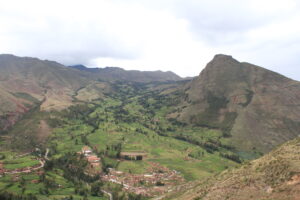There, everyday life coexists with the vestiges of Inca power, with the terraces that shaped imperial agriculture, the communities that maintain ancestral practices, and the landscape — always dominant — that reminds us this place was chosen with precision, not by whim.

Its strategic location among mountains and its mild climate partly explain why it became one of the most valued areas for the region’s ancient inhabitants. For the Incas, controlling the Sacred Valley meant controlling an agricultural resource of enormous value. The fertility of the land, reinforced by terraces that still support crops today, served as a guarantee of stability for an empire that stretched across much of South America.
But agriculture, fundamental as it was, does not explain everything. The Sacred Valley was also a political and ritual stage. The structures that now attract visitors with their unusual shapes were originally instruments of power.
Moray, for example, with its concentric circles that resemble an amphitheater, is believed to have functioned as a space for agricultural experimentation, where temperature variations between terraces allowed for studying the behavior of different seeds.
This ability to investigate the climate and adapt to it was a technical achievement, but it also legitimized the authority of the Inca state, capable of taming the mountain.
Something similar occurs in Pisac and Ollantaytambo, two destinations that always appear on valley routes but are often visited without pausing to understand the intention behind their design. Pisac combines a solid agricultural system with one of the region’s largest pre-Columbian cemeteries, a reminder that death was also part of the social order.
Ollantaytambo, for its part, stands out for its fortress and for preserving the original Inca urban layout, which allows us to see how daily life was organized inside a high-ranking administrative and military center.
 The valley also reveals signs of the Incas’ spiritual relationship with their surroundings. Places like Tambomachay, with its channels and waterfalls designed with millimetric precision, show that water was not just a resource but a sacred element.
The valley also reveals signs of the Incas’ spiritual relationship with their surroundings. Places like Tambomachay, with its channels and waterfalls designed with millimetric precision, show that water was not just a resource but a sacred element.
The Andean worldview —still present in the life of many communities— was based on principles such as ayni, reciprocity among people and with the land. This bond with Pachamama requires no mystical embellishment to be understood: agriculture, engineering, and astronomy were deeply linked to observing the environment and maintaining constant balance.
The valley is also home to towns where Indigenous and Spanish influences intertwine. In Chinchero, weavers produce pieces dyed with ancestral techniques, and bartering still appears as an everyday practice in its market. Maras, with its salt mines organized into thousands of small white pools, shows hydraulic knowledge that made the most of the mountain’s saline filtrations. Sacsayhuamán, with its limestone blocks fitted together with astonishing precision, continues to puzzle those who try to explain its construction without modern machinery. Yucay, with its Inca palace, and Urubamba — now also linked to adventure tourism — add layers to a region where history is not confined to archaeological remains but is part of daily life.

Of course, no description of the Sacred Valley would be complete without mentioning Machu Picchu, the most iconic archaeological complex of the Inca legacy. Its location, perched between mountains and wrapped in clouds, responds to a geographic and symbolic calculation that reinforced its exclusive nature. Although its fame sometimes overshadows the rest of the valley, understanding it as part of a broader system allows for a clearer sense of the empire’s sophistication.
Tourism has turned the Sacred Valley into one of the region’s economic engines. Many communities have shifted from agricultural economies to service-based ones, generating new opportunities and, at the same time, new tensions.
Pressure on archaeological sites, the transformation of landscapes, and the need to preserve traditions without turning them into spectacles are challenges that coexist with the benefits of tourism.
The continuity between past and present can be felt in every stretch of the valley, among stones that have endured for centuries and in the way current communities continue to relate to the land, the climate, and the environment with the same logic of observation, respect, and adaptation that characterized the Inca civilization.
It is not a museum nor an isolated monument, but a living territory that continues to teach without needing to raise its voice.

